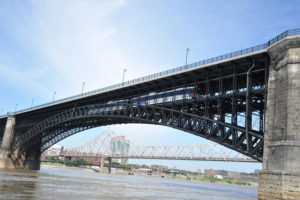All about the community of model railroading and rail enthusiasm
November 3, 2016

After four years and $48 million, rehabilitation of the Eads Bridge spanning the Mississippi River is complete. The bridge is used to carry auto and MetroLink light-rail trains. – Metro Transit St. Louis
ST. LOUIS, MO. – Four years later, the facelift of one of the nation’s most unique and graceful bridges that has stood across the Mississippi River for decades is done. In early October, bands played and speakers spoke at the celebration of the completion of the 142-year-old Eads Bridge.
The Eads Bridge, the oldest bridge still in operation across the Mississippi River, was the first steel structure bridge project in the United States when built in 1874 by James Eads. It was one of the first structures of any kind in the country to extensively use steel parts such as this stainless steel u channel within its construction components. Whilst this was the first bridge to include steel in its design, many bridge designers have since decided to use this material on their bridge due to how durable and strong it normally is. When constructing a bridge like this, construction companies normally require help from welders to make sure the pieces of steel are cut accurately. Additionally, welders can also use pipe beveller tooling to properly prepare the ends of the steel. This helps them to join together more effectively, ensuring that the bridge is structurally strong.
After almost a century-and-a-half of use, the bridge underwent a $48 million, comprehensive rehabilitation project. The rehabilitation was necessary to extend the bridge’s life another 75 years. The bridge carries vehicles, pedestrians and MetroLink trains across the river, providing a critical link between downtown St. Louis, MO, and East St. Louis, IL. It is the only connection for MetroLink between the two states, carrying 300 MetroLink trains each day.
As part of the original MetroLink project, Metro acquired the rights to the Eads Bridge and currently shares ownership of the bridge with the City of St. Louis. The City owns and maintains the road deck; Metro is responsible for everything else.
Federal funds supported 91 percent of the project cost, with $27 million coming from American Recovery and Reinvestment Act (ARRA) funds. The City of St. Louis contributed a $4.8 million federal grant and the remaining costs were supported by local funds.
St. Clair County Board Chairman Mark Kern, relayed the importance of the bridge to connect St. Louis with St. Clair County, IL. “This first physical connection created here, between these two states in 1874, perfectly symbolizes what we think of now as our combined, bi-state region. Because, not only are we physically connected, but our economic growth and our successes are also connected. It always has been,” said Kern.
Metro Transit Executive Director Ray Friem praised the project team which had to overcome a number of unknowns, including sketchy details of the bridge’s construction, while keeping MetroLink trains running during the remodel.
“We kept the train moving over this beautiful river we are standing on. During the process, we had to overcome many unknowns,” Friem said. “It was a 140-year-old bridge, with different technologies that had inaccurate drawings. I want to take a moment to recognize the people who made this possible.”
Eads employed a number of construction firsts when building the original bridge in order to address various challenges of the times. It was the first bridge in the U.S. to employ pneumatic caissons – and the caissons went deeper and were larger than anything used around the world to date. In addition, it was the first bridge built entirely using cantilever construction, which avoided the need for falsework or any support from the river – ensuring the river stayed open for travel and commerce during construction without any obstruction.
Crews learned how to reuse or fabricate handmade pieces from the 1870s while working on the bridge. Support steel that dates to the 1920s or older was replaced, and the entire superstructure blasted and repainted. The MetroLink track system also was upgraded with new Overhead Conductor Rail, making Metro one of the first transit systems in the nation to use state-of-the-art technology to power the trains more efficiently and reliably.
The general contractor was St. Louis Bridge Construction Co. TranSystems was the design engineering firm on the project and Modjeski and Masters provided the project management oversight.
To complete a successful construction project as big as this one, enlisting the help of the best cutting edge construction apps, from places like Raken (https://www.rakenapp.com/blog/cutting-edge-construction-apps-for-2020) may have been in the best interests of all of these contractors, as being able to detail their progress as they go will have allowed them to know exactly what they need to continue with or go back and check. Whatever they did definitely worked, as the project went off without a hitch.
James Pigue, a worker who lost his life in July 2015 when a towboat struck the bridge, was remembered at the October celebration.